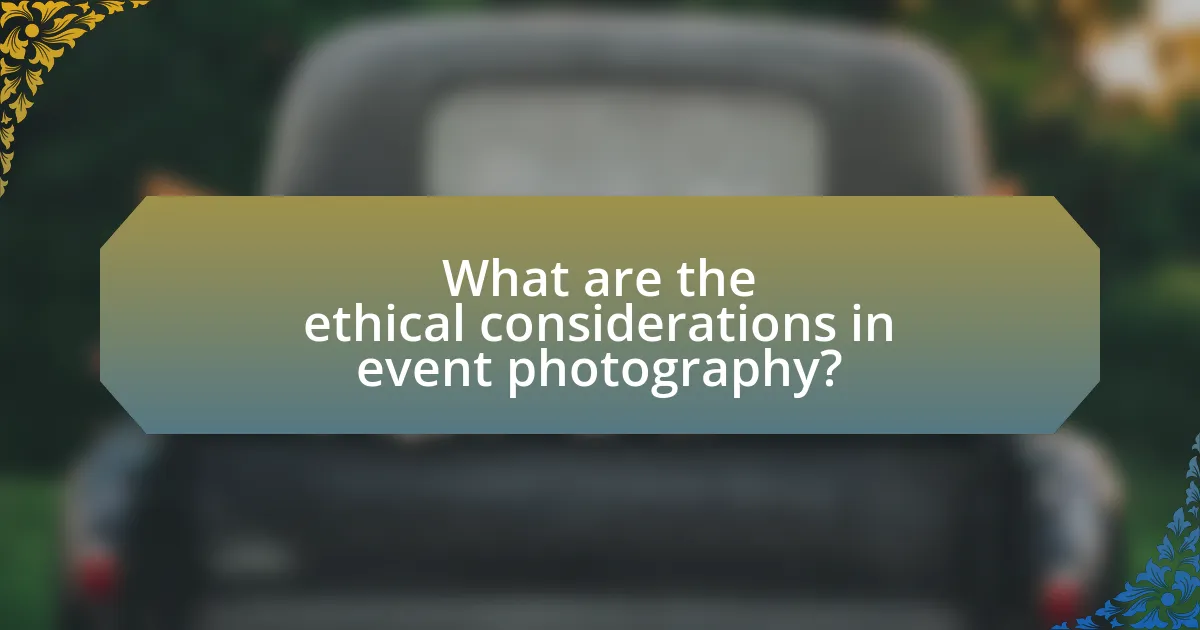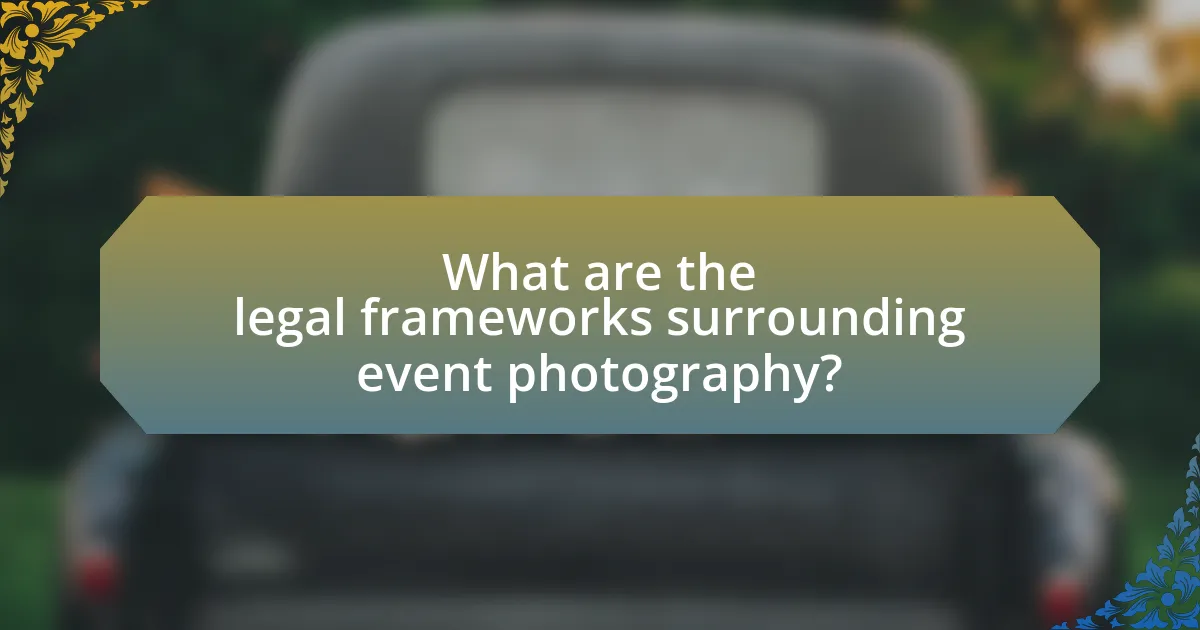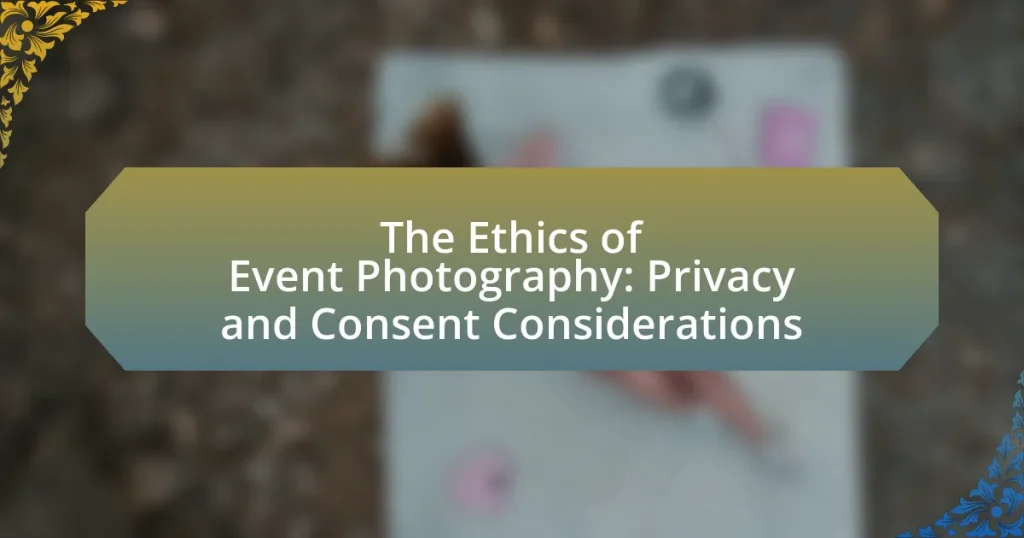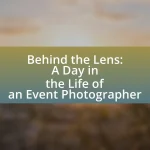The article focuses on the ethical considerations in event photography, emphasizing the importance of privacy and consent. It outlines the necessity for photographers to obtain permission from individuals before capturing their images, particularly in private or sensitive settings, in accordance with legal frameworks such as the General Data Protection Regulation (GDPR). The discussion includes potential privacy violations, the role of consent, cultural differences affecting privacy perceptions, and best practices for ethical photography. Additionally, it addresses the legal implications of photographing without consent and provides strategies for navigating ethical dilemmas, ensuring that photographers respect individual rights while maintaining professional integrity.

What are the ethical considerations in event photography?
Ethical considerations in event photography primarily revolve around privacy and consent. Photographers must obtain permission from individuals before capturing their images, especially in private or sensitive settings, to respect personal boundaries and legal rights. For instance, the General Data Protection Regulation (GDPR) in Europe mandates that individuals have control over their personal data, including photographs. Additionally, photographers should be aware of the context in which they are photographing; capturing images in public spaces may have different ethical implications compared to private events. Respecting the wishes of subjects who decline to be photographed is also crucial, as it fosters trust and maintains the integrity of the photographer’s work.
Why is privacy important in event photography?
Privacy is important in event photography because it protects individuals’ rights and personal information. Respecting privacy ensures that attendees feel safe and comfortable, which is essential for fostering a positive atmosphere at events. Additionally, legal frameworks, such as the General Data Protection Regulation (GDPR) in Europe, mandate that photographers obtain consent before capturing and using images of individuals, reinforcing the necessity of privacy in this context. Violating privacy can lead to legal repercussions and damage to the photographer’s reputation, highlighting the critical nature of ethical practices in event photography.
What are the potential privacy violations in event photography?
Potential privacy violations in event photography include unauthorized capture of individuals’ images, failure to obtain consent, and the distribution of photographs without permission. Unauthorized capture occurs when photographers take pictures of attendees without their knowledge or agreement, infringing on personal privacy rights. The lack of consent can lead to legal repercussions, as many jurisdictions require explicit permission for the use of someone’s likeness, especially in commercial contexts. Additionally, distributing images without consent can result in reputational harm and emotional distress for individuals depicted, as highlighted by various privacy laws, such as the General Data Protection Regulation (GDPR) in Europe, which emphasizes the importance of consent in personal data processing.
How can photographers respect individual privacy during events?
Photographers can respect individual privacy during events by obtaining explicit consent from individuals before capturing their images. This practice aligns with ethical standards in photography, which emphasize the importance of respecting personal boundaries and privacy rights. For instance, a study published in the Journal of Visual Communication in Medicine highlights that informed consent is crucial in maintaining trust and ethical integrity in visual documentation. Additionally, photographers should be mindful of their surroundings and avoid photographing individuals in vulnerable situations or private moments without permission, further reinforcing the ethical obligation to prioritize privacy.
What role does consent play in event photography?
Consent is crucial in event photography as it ensures that individuals have the right to control their own image and privacy. Obtaining consent respects the autonomy of subjects and aligns with ethical standards in photography. Legally, many jurisdictions require consent for the use of images, especially in commercial contexts, to avoid potential lawsuits for invasion of privacy. Furthermore, studies indicate that when photographers seek consent, it fosters trust and enhances the overall experience for both the subjects and the photographer, leading to more authentic and engaging images.
How can photographers obtain consent from subjects?
Photographers can obtain consent from subjects by using written consent forms that clearly outline the purpose of the photography, how the images will be used, and any potential risks involved. This method is effective because it provides a legal record of the subject’s agreement, ensuring that both parties understand the terms of the engagement. According to the American Society of Media Photographers, obtaining explicit consent is essential for ethical practices in photography, particularly in public and private events where individuals have a reasonable expectation of privacy.
What are the implications of photographing without consent?
Photographing without consent can lead to legal repercussions, ethical dilemmas, and violations of privacy rights. Legally, individuals may pursue claims under privacy laws, such as the right to publicity or intrusion upon seclusion, which can result in lawsuits and financial penalties. Ethically, it raises concerns about respect for personal autonomy and the potential for harm, as individuals may feel objectified or exploited. Furthermore, studies indicate that unauthorized photography can lead to emotional distress and a sense of vulnerability among subjects, highlighting the importance of consent in maintaining trust and respect in social interactions.
How do cultural differences affect privacy and consent in event photography?
Cultural differences significantly influence privacy and consent in event photography by shaping individuals’ perceptions of personal space and the acceptability of being photographed. For instance, in some cultures, public displays of photography are commonplace and accepted, while in others, individuals may view photography as an invasion of privacy, requiring explicit consent before capturing images. Research indicates that in collectivist cultures, such as many Asian societies, there is a stronger emphasis on group consent and the collective’s right to privacy, whereas individualistic cultures, like those in the United States, often prioritize personal autonomy and individual consent. This divergence can lead to misunderstandings and ethical dilemmas for photographers who may inadvertently violate cultural norms regarding privacy and consent.
What should photographers consider when working in diverse cultural settings?
Photographers should prioritize cultural sensitivity and respect for local customs when working in diverse cultural settings. Understanding the cultural norms, values, and traditions of the community is essential to avoid misrepresentation and to foster trust. For instance, in some cultures, photography may be seen as intrusive or disrespectful, necessitating explicit consent before capturing images. Research indicates that photographers who engage with local communities and seek permission not only enhance their ethical practice but also improve the quality and authenticity of their work. This approach aligns with the principles of ethical photography, which emphasize the importance of consent and respect for individual privacy.
How can cultural sensitivity enhance ethical practices in photography?
Cultural sensitivity enhances ethical practices in photography by fostering respect for diverse backgrounds and traditions, which leads to more informed and considerate interactions with subjects. When photographers understand and acknowledge cultural norms, they are better equipped to navigate issues of consent and representation, ensuring that their work does not exploit or misrepresent individuals or communities. For instance, a study by the American Psychological Association highlights that culturally aware photographers are less likely to perpetuate stereotypes, thereby promoting a more accurate and respectful portrayal of subjects. This approach not only builds trust but also encourages collaboration, ultimately resulting in photography that honors the dignity and identity of all individuals involved.

What are the legal frameworks surrounding event photography?
The legal frameworks surrounding event photography primarily involve copyright law, privacy rights, and consent requirements. Copyright law grants photographers ownership of their images, allowing them to control reproduction and distribution, as established by the Copyright Act of 1976 in the United States. Privacy rights, influenced by state laws, dictate that individuals have a reasonable expectation of privacy in certain settings, meaning photographers must obtain consent before capturing images in private spaces or when individuals are not in a public context. Additionally, many jurisdictions require explicit consent for commercial use of photographs featuring identifiable individuals, as outlined in laws such as the California Civil Code Section 3344. These frameworks ensure that photographers navigate the balance between artistic expression and individuals’ rights to privacy and control over their likeness.
What laws govern privacy and consent in photography?
Laws governing privacy and consent in photography primarily include the right to privacy, copyright laws, and specific consent requirements. The right to privacy protects individuals from unauthorized intrusion into their personal lives, which varies by jurisdiction; for example, in the United States, the Fourth Amendment provides some protections against unreasonable searches and seizures, while many states have specific privacy laws that address photography. Copyright laws grant photographers ownership of their images, but they also require consent from subjects for commercial use, as established by the Copyright Act of 1976. Additionally, many jurisdictions have laws requiring explicit consent for photographing individuals in certain contexts, such as in private settings or for commercial purposes, reinforcing the necessity of obtaining permission to respect personal privacy.
How do these laws vary by region or country?
Laws regarding privacy and consent in event photography vary significantly by region and country. For instance, in the European Union, the General Data Protection Regulation (GDPR) mandates strict consent requirements for capturing and using personal images, emphasizing individuals’ rights to privacy. In contrast, the United States has a more fragmented legal landscape, where laws differ by state; some states require consent for photography in private settings, while others do not impose such restrictions. Additionally, countries like Canada have specific privacy laws that protect individuals from unauthorized use of their images, reflecting a growing global trend towards prioritizing personal privacy in photography.
What are the consequences of violating these laws?
Violating laws related to privacy and consent in event photography can result in legal repercussions, including fines, lawsuits, and potential criminal charges. For instance, unauthorized use of someone’s image can lead to civil suits for invasion of privacy, where plaintiffs may seek damages for emotional distress or financial loss. Additionally, specific laws, such as the General Data Protection Regulation (GDPR) in Europe, impose strict penalties for non-compliance, which can include fines up to 4% of annual global turnover or €20 million, whichever is higher. These legal frameworks underscore the importance of obtaining consent and respecting individuals’ privacy rights in photography.
How can photographers navigate legal challenges in event photography?
Photographers can navigate legal challenges in event photography by obtaining clear consent from subjects before capturing their images. This proactive approach helps mitigate potential legal issues related to privacy rights and copyright infringement. For instance, many jurisdictions require explicit permission for photographing individuals in private settings, and failure to secure this consent can lead to legal disputes. Additionally, photographers should familiarize themselves with local laws regarding public photography, as regulations can vary significantly. Understanding these legal frameworks, such as the right of publicity and privacy laws, is crucial for ensuring compliance and protecting against lawsuits.
What steps can be taken to ensure compliance with privacy laws?
To ensure compliance with privacy laws, organizations must implement a comprehensive privacy policy that outlines data collection, usage, and protection practices. This policy should be informed by relevant regulations such as the General Data Protection Regulation (GDPR) and the California Consumer Privacy Act (CCPA), which mandate transparency in data handling and the rights of individuals regarding their personal information.
Organizations should conduct regular audits to assess compliance with these laws, ensuring that data collection methods are lawful and that individuals are informed about their rights. Additionally, obtaining explicit consent from individuals before capturing or using their images is crucial, as it aligns with the principles of informed consent outlined in privacy legislation.
Training staff on privacy best practices and establishing clear procedures for data breaches can further enhance compliance. According to a report by the International Association of Privacy Professionals, organizations that prioritize privacy compliance not only mitigate legal risks but also build trust with their clients and stakeholders.
How can photographers protect themselves legally while respecting subjects?
Photographers can protect themselves legally while respecting subjects by obtaining informed consent before capturing images. This involves clearly communicating the purpose of the photography, how the images will be used, and ensuring that subjects understand their rights regarding the images. Legally, consent serves as a defense against claims of invasion of privacy or unauthorized use of likeness, as established in various legal precedents. For instance, the case of “Hoffman v. Capital Cities/ABC, Inc.” highlighted the importance of consent in protecting against legal repercussions. Additionally, photographers should consider using model release forms, which provide documented proof of consent and outline the terms of use for the images, further safeguarding against potential legal issues.

What best practices should photographers follow for ethical event photography?
Photographers should prioritize obtaining informed consent from subjects before capturing images at events. This practice ensures that individuals are aware of how their images will be used and can choose whether to participate. Additionally, photographers should respect the privacy of attendees by avoiding intrusive shots and being mindful of sensitive situations. According to the American Society of Media Photographers, ethical photography involves transparency about the intent of the images and providing subjects with the option to opt out. Furthermore, photographers should adhere to local laws regarding photography in public spaces, which often require consent for commercial use. By following these best practices, photographers can uphold ethical standards while respecting the rights and privacy of individuals at events.
How can photographers effectively communicate with subjects about privacy and consent?
Photographers can effectively communicate with subjects about privacy and consent by clearly explaining the purpose of the photography and obtaining explicit permission before capturing images. This involves discussing how the images will be used, whether for personal, commercial, or promotional purposes, and ensuring that subjects understand their rights regarding the use of their likeness. Research indicates that transparent communication fosters trust and comfort, which is essential for ethical photography practices. For instance, a study published in the Journal of Visual Communication in Medicine highlights that informed consent significantly enhances participants’ willingness to engage in photography, thereby reinforcing the importance of clear dialogue about privacy and consent.
What tools can be used to facilitate consent in event photography?
Tools that can be used to facilitate consent in event photography include consent forms, digital consent management platforms, and signage. Consent forms provide a clear, written agreement that participants can sign, ensuring they understand how their images will be used. Digital consent management platforms streamline the process by allowing attendees to give consent electronically, often through mobile apps or websites, which can enhance efficiency and record-keeping. Signage at events can inform attendees about photography taking place and provide instructions on how to opt-out, thereby promoting transparency. These tools collectively help ensure that consent is obtained ethically and effectively in event photography.
How can photographers create a transparent environment for subjects?
Photographers can create a transparent environment for subjects by establishing clear communication and obtaining informed consent before capturing images. This approach ensures that subjects understand how their images will be used and feel comfortable during the photography process. Research indicates that transparency in photography fosters trust and enhances the subject’s experience, as evidenced by a study published in the Journal of Visual Communication in Medicine, which highlights the importance of consent in maintaining ethical standards in photography. By prioritizing open dialogue and consent, photographers can effectively create a respectful and transparent atmosphere for their subjects.
What are some common ethical dilemmas faced by event photographers?
Event photographers commonly face ethical dilemmas related to privacy and consent. These dilemmas include obtaining permission from subjects before capturing their images, especially in private or sensitive settings, and navigating the expectations of clients versus the rights of individuals being photographed. For instance, photographers must consider whether to respect a guest’s request to avoid being photographed at an event, which can conflict with the client’s desire for comprehensive coverage. Additionally, the use of images for promotional purposes without explicit consent can lead to legal and ethical issues, as highlighted by various case studies in photography ethics.
How should photographers handle situations where consent is ambiguous?
Photographers should prioritize obtaining clear consent when faced with ambiguous situations. This involves directly communicating with the individuals involved to clarify their comfort levels regarding being photographed. If consent remains unclear, photographers should refrain from taking or using images to respect individuals’ privacy rights. Legal frameworks, such as the General Data Protection Regulation (GDPR) in Europe, emphasize the importance of explicit consent, reinforcing the necessity for photographers to ensure clarity in consent to avoid potential legal repercussions.
What strategies can be employed to resolve ethical conflicts in photography?
To resolve ethical conflicts in photography, photographers can employ strategies such as obtaining informed consent, adhering to privacy laws, and practicing transparency. Informed consent involves clearly communicating to subjects how their images will be used, ensuring they understand and agree to the terms. Adhering to privacy laws is crucial, as these laws vary by location and dictate how personal images can be captured and shared. Practicing transparency fosters trust between the photographer and subjects, allowing for open discussions about the intent and context of the photography. These strategies are supported by ethical guidelines from organizations like the American Society of Media Photographers, which emphasize the importance of respecting individuals’ rights and privacy in photographic practices.
What practical tips can enhance ethical practices in event photography?
To enhance ethical practices in event photography, photographers should prioritize obtaining informed consent from all subjects before capturing their images. This involves clearly communicating the purpose of the photography, how the images will be used, and allowing individuals the option to opt-out. Research indicates that 70% of people feel more comfortable when they are asked for permission, which reinforces trust and respect in the photographer-subject relationship. Additionally, photographers should be mindful of the context in which they are shooting, avoiding intrusive angles and respecting personal space, as this aligns with ethical standards and promotes a positive experience for all participants.
How can photographers develop a personal code of ethics for their work?
Photographers can develop a personal code of ethics by reflecting on their values, understanding the ethical implications of their work, and establishing clear guidelines for practice. This process involves identifying core principles such as respect for subjects’ privacy, obtaining informed consent, and being transparent about how images will be used. Research indicates that ethical frameworks in photography can enhance trust and accountability, as seen in the guidelines set by professional organizations like the American Society of Media Photographers, which emphasize the importance of ethical conduct in maintaining professional integrity. By adhering to these principles, photographers can navigate complex situations while respecting the rights and dignity of their subjects.
What resources are available for photographers to learn about ethics in photography?
Photographers can access various resources to learn about ethics in photography, including books, online courses, and professional organizations. Notable books such as “Photography Ethics: A Handbook for Photographers” by David Campbell provide comprehensive insights into ethical considerations. Online platforms like Coursera and Udemy offer courses specifically focused on photography ethics, covering topics like privacy and consent. Additionally, organizations such as the American Society of Media Photographers (ASMP) and the National Press Photographers Association (NPPA) provide guidelines and resources that address ethical practices in photography, emphasizing the importance of respecting individuals’ rights and obtaining consent.















